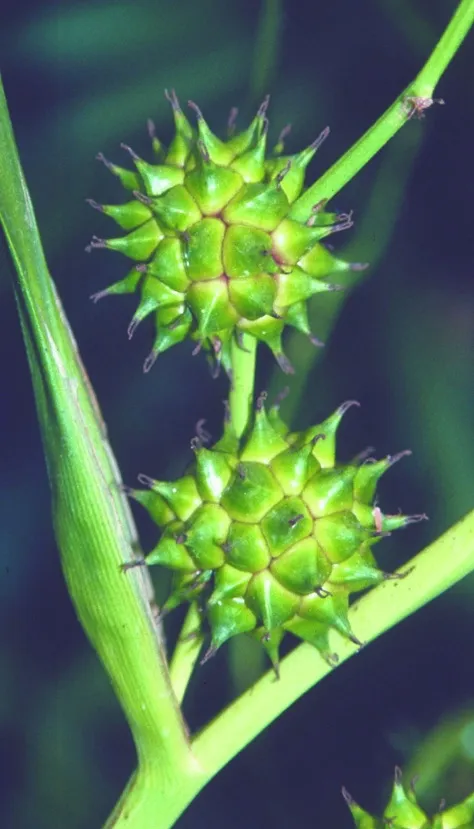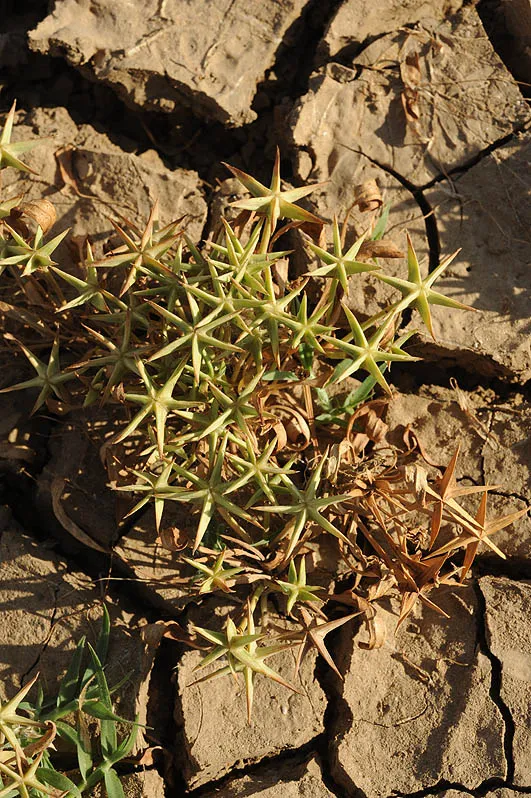Simplestem Bur-reed, Branched Bur-reed
Sparganium erectum

The roots and stem bases of Sparganium
erectum contain a lot of starch and are edible
after cooking. The fruits are an important food source for birds in autumn and
early winter
Sparganium erectum now grows
mainly in the Sharon, the Hula Valley and the Golan Heights. In the past, it
was probably common in the Hula marshes, in the streams in the upper Jordan
River system and in coastal streams. Its range decreased in recent decades
following the drainage of the Hula and the lack of clean water flow in most of the
Sharon streams. The main populations that survived in the Hula Valley are found
in the Nuhela marshes, in the Dan Stream and in the Gonen springs. In the Golan
it was seen in the Zavitan Stream near the Customs House. In the Sharon there
are currently a few populations, mainly in Ahu Binyamina (some 500 plants were
observed there), in the
Ya'ar Pond and there is a record from 1980 from
the Batih Pond, northeast of
Hadera. In 1997, it was seen at the boundary between the Sharon and Philistian
regions, at the Yarkon sources. In the past, it was also collected from other regions:
in the Jezreel Valley (Nahalal and Balfouria) and in the Philistian Plain – in the
Yarkon, Wadi Ayalon and Wadi Sorek (Nebi Rubin, Palmahim). Recent surveys of
the two sites found no other populations in these regions. There is also a
herbarium specimen collected by Noah Naftolsky in 1925 from Wadi Zarqa in
Samaria, but there is no knowledge of existence of this population today.
Sparganium
erectum grows on the banks of lakes, rivers and canals with
permanent clean water. An aquatic plant that usually inhabits abundantly flowing
clean water bodies. Usually rooted in the muddy bottom and the base of the shoot
is covered with a layer of water about 20 cm deep. It is uprooted by strong
water flows, and is not resistant prolonged emersion of the whole plant. Formerly
grew in the outer zone of the Hula Lake before it was drained.
Sparganium is the only genus
in the Sparganiaceae
family, which numbers 14 species found in the temperate regions of
the northern hemisphere; 7 species in Europe and 10 in North America. Some of
the species cross the equator and reach Malaysia and Australia. The genus and
family differ from the other monocotyledonous groups that are similar to it (Cyperaceae,
Juncaceae, and Typha) in its spherical inflorescence. In the Middle East three
species grow, two limited only to Turkey and the third is S. erectum.
·
The
number of sites where Sparganium erectum grew declined sharply in the first half of the 20th century due
to the severe damage to clean streams and wetlands in the country, particularly
after the drainage of the Hula Marshes. The disappearance of the habitat and the
deterioration of the water quality are therefore the main threat to the surviving
populations.
·
The
populations are fragmented according to the degree of fragmentation of suitable
habitats, and are kilometers to tens of kilometers apart.
·
S. erectum population sizes vary between a few, to tens or hundreds of plants.
The plants within a population stand are not very dense but sometimes form clusters.
·
S. erectum is protected in Israel in the Tel Dan Nature Reserve and is
found within the boundaries of the proposed Ahu Binyamina and Ya'ar Pond reserves.
·
Apparently,
it is not globally endangered.
The Hula Valley and Sharon Sparganium erectum
populations should be regularly monitored. The Ahu Binyamina and Ya'ar
Pond in the Sharon should be formally declared reserves. The species should be
reintroduced to additional water bodies in the Hula Valley such as
the Hula Lake.
Sparganium erectum is found in all
the European countries and the Middle East (including the southern countries –
Tunisia and Libya) in aquatic habitats. It continues eastwards to the Black Sea
countries, the Caucasus and Central Asia. S. erectum also grows in North
America.
In the Middle East, S. erectum grows in all the regions
of Turkey, in Cyprus, the Syria-Lebanon coastal areas and the central and
northern regions in Iran. It is absent from Jordan and from all countries south
of Israel.
Sparganium erectum is an emergent aquatic plant of
fresh water wetlands. The number of regions and sites where it grows has
decreased considerably since the mid-20th century. The main threat to the surviving
S. erectum populations is the sensitivity of aquatic habitats in Israel
and the risk of further deterioration of their water quality. S. erectum
is a southern peripheral species, whose southern distribution limit is in Israel.
Current Occupancy Map
| 1000 squre meter pixel | 5000 squre meter pixel | 10000 squre meter pixel | |
|---|---|---|---|
| number of observations | 0 | 0 | 0 |
| in total pixels | 0 | 0 | 0 |
| Family | Sparganiaceae |
| Classification | On the endangered species list |
| Ecosystem | Mediterranean humid |
| Chorotype | Euro – Siberian, Mediterranean and Irano - Turanian |
| Conservation Site | Ahu Binyamina |
| Rarity |
1
2
6
|
|---|---|
| Vulnerability |
0
4
4
|
| Attractiveness |
0
0
4
|
| Endemism |
0
0
4
|
| Red number |
1
3.7
10
|
| Peripherality | N |
| IUCN category | DD EW EX LC CR EN VU NT |
| Threat Definition according to the red book | Vulnerable |
 Based on:
Based on:






